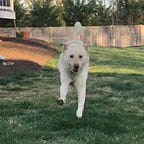Dog Bite Prevention and Kids: Beyond Supervision
This week is National Dog Bite Prevention Week, an event sponsored by the American Veterinary Medical Association (AVMA). It is all about educating people in ways to prevent dog bites.
Any dog can bite. Let’s get that out of the way right up front. Every dog has a bite threshold — the level of fear or stress that, when exceeded, results in a bite.
Some prevention tactics are common sense, like staying away from a dog who is growling at you and teaching your child to ask permission before petting someone else’s dog. Parents (or anyone in charge of tiny humans) are advised to only let children pet dogs gently, and not to let them touch a dog that is eating. But this advice is fairly general. Having lived with a tiny human myself for the last 2 years, I know it isn’t always easy. Repeating the words “leave doggy alone,” doesn’t seem to resonate with toddlers.
Ever since we started allowing our child to interact with our dogs, we have taught her some more specific “rules.” Starting from the time she was interested in touching the dogs, we have practiced “one hand petting.” Kids tend to grab dogs for stability, accidentally pull fur, or make dogs feel trapped with face hugs and kisses. My daughter is now pretty consistent at petting our dogs Ruthie and Meera with only one hand, since it has always been the norm for her.
I’m not saying she has never used two hands — she is a toddler, after all. If she is using two hands and a reminder to use only one hand is unsuccessful, we simply stop the interaction: we either step between her and the dog, pick her up, or call the dog away. We also practice “wave hello” to other dogs (as well as to our third dog, Lady, who is quite fearful).
She also loves to help feed the dogs and to watch them eat. At first she would try to watch very closely. Too closely! The problem was, asking her to stand back or trying to get her to move further away resulted in only a tiny toddler step or two. Instead, we have taught her that she has to stay behind the line where our wood floor becomes our tile floor. This visual line has been much easier for her to understand, and now she will watch from a safe distance. That’s right, I basically taught my child a “place” cue.
These are two examples of how I prevent our daughter from getting bitten — not only with our own dogs, but with any dog she meets. It’s an ongoing learning process. As a trainer, I feel that it’s my responsibility to help people teach these skills with more specific language and rules. After all, I don’t expect to say “leave the squirrel alone” to my dog and have her respond “yes mother.” At least, not without training her first.
